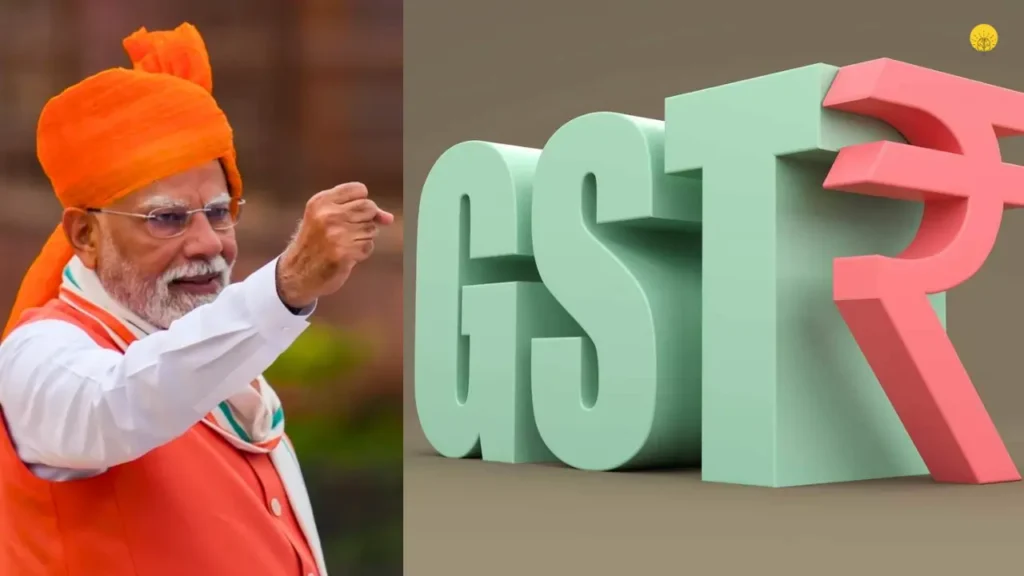New Delhi: Prime Minister Narendra Modi has unveiled a transformative vision for the Goods and Services Tax (GST), marking its most significant overhaul since its inception in 2017. Announced during the 79th Independence Day celebrations and reinforced at the inauguration of key infrastructure projects, these next-generation GST reforms are set to deliver a “Diwali gift” to the nation by October 20, 2025. Targeting the poor, middle class, farmers, women, students, traders, entrepreneurs, and MSMEs, the reforms aim to simplify taxation, reduce compliance burdens, and foster an ‘Atmanirbhar Bharat’ (self-reliant India). Built on three pillars—structural reforms, rate rationalization, and ease of living—the initiative draws on eight years of GST implementation to create a more equitable, sustainable, and business-friendly tax system.
GST Reforms 2025

GST: A Cornerstone of Economic Integration
Introduced via the 101st Constitutional Amendment Act, GST unified a complex web of central and state indirect taxes, such as excise duty and service tax, under the “One Nation, One Tax” framework. Governed by the GST Council, it operates through a dual structure of Central GST (CGST) and State GST (SGST). While GST has streamlined taxation, challenges like inverted duty structures, classification disputes, and multiple tax slabs have persisted. PM Modi, addressing the nation from the Red Fort on August 15, 2025, hailed GST as a landmark reform that has benefited India and emphasized the need for its next phase to amplify these gains.
Three Pillars of Next-Gen GST Reforms
The Central Government has submitted a comprehensive proposal to the Group of Ministers (GoM) constituted by the GST Council, focusing on three foundational pillars to address systemic inefficiencies and enhance taxpayer experience.
Pillar 1: Structural Reforms for Stability
The first pillar tackles structural issues head-on. A key focus is correcting inverted duty structures, where input tariffs exceed output taxes, leading to accumulated input tax credits and discouraging domestic value addition. This also occurs when inputs are taxed, but final outputs are exempt. By aligning input and output tax rates, the reforms aim to reduce credit build-up and bolster local manufacturing.
Resolving classification issues is another priority. Streamlining rate structures will minimize disputes, simplify compliance, and ensure equity across sectors, reducing litigation and fostering fairness. Additionally, the reforms emphasize long-term stability and predictability, offering clarity on rates and policies to boost industry confidence and facilitate better business planning.
Pillar 2: Rate Rationalization for Affordability
Rate rationalization, the second pillar, seeks to make essential and aspirational goods more affordable, particularly for the common man, women, students, middle class, and farmers. The government plans to reduce tax slabs to two primary rates—a standard 18% and a merit 5%—with special rates reserved for select items. Most items currently taxed at 28% will shift to 18%, while “sin goods” like tobacco and gutka will move to a new 40% bracket to maintain revenue streams.
The early repayment of loans tied to the Compensation Cess, originally extended to March 31, 2026, has created fiscal space. This allows for sustainable rate alignment without compromising revenue. Officials anticipate that reduced rates will boost consumption and compliance, offsetting any short-term revenue dips. “Reduced rates will not lead to reduced revenues; we expect compliance and collections to go up,” a senior official noted, highlighting the fiscally sustainable approach.
Pillar 3: Ease of Living Through Technology
The third pillar focuses on ease of living, leveraging technology to simplify GST processes. Registration will become seamless, time-bound, and technology-driven, particularly benefiting small businesses and startups. Pre-filled returns will reduce manual intervention, eliminate mismatches, and save time. For exporters and those affected by inverted duties, refunds will be processed faster and automatically, addressing a major pain point.
These measures align with the government’s commitment to enhancing Ease of Doing Business (EoDB), formalizing the economy, and promoting inclusive growth. As PM Modi stated on August 17, 2025, during the inauguration of the Delhi section of the Dwarka Expressway and Urban Extension Road-II, the reforms will benefit “every family, the poor and the middle class, small and big entrepreneurs, and every trader and businessman.”
Implementation Timeline and Cooperative Federalism
The Centre’s proposal is under review by two GoMs—one on rate rationalization and another on compensation cess—comprising state representatives. The GST Council will deliberate on their recommendations in upcoming meetings, with the government targeting implementation by Diwali 2025 to deliver benefits within the current financial year.
In the spirit of cooperative federalism, the Centre is engaging states to build consensus. PM Modi expressed confidence in state support, stating, “I hope that all the States will cooperate with this initiative of the Government of India.” The absence of central representation in the rate rationalization GoM means any rejection could frame states as opposing tax relief for the common man. The early cessation of the Compensation Cess, driven by preemptive loan repayment, adds urgency, as it risks lowering taxes on sin goods unless addressed through the new 40% slab.
Broader Context: Independence Day and Security
During his Red Fort address, PM Modi, donning a saffron turban, celebrated India’s achievements, including the success of Make in India. He framed GST reforms as part of continuous governance improvements, stating, “For us, reform signifies the advancement of good governance.” He also hailed “Operation Sindoor,” a military response to the Pahalgam terror attack, and issued a stern warning against Pakistan’s nuclear blackmail: “If our enemies persist in such attempts, our armed forces will respond on their own terms, at a time of their choosing.”
While security dominated parts of the speech, the GST announcement underscored economic priorities. A Ministry of Finance press release reaffirmed the commitment to a simple, stable, and transparent tax system.
Opposition and Long-Term Vision
The Congress party has called for a discussion paper on “GST 2.0,” hinting at potential debates. However, government sources describe the reforms as a “game changer,” paving the way for a single tax slab by 2047, aligning with India’s centennial independence goals. The proposed structure, with 18% and 5% rates, aims to fulfill GST’s original intent of simplicity and rationality, eliminating the 12% and 28% slabs.
Economic Impact and Stakeholder Benefits
The reforms are poised to stimulate key sectors by reducing compliance burdens, resolving disputes, correcting inverted duties, and ensuring rate stability. Lower taxes on essentials and aspirational goods will boost demand, while pre-filled returns and automated refunds will ease business operations, particularly for MSMEs, farmers, and exporters. Traders will benefit from fewer slabs and disputes, supporting the formal economy and EoDB.
According to a PIB Delhi release on August 15, 2025, the Centre is committed to inclusive dialogue with states for swift implementation. As global uncertainties and U.S. tariff threats loom, sources clarify that the timing is coincidental, but the reforms position India for economic resilience.
A Diwali Gift for All
PM Modi’s next-generation GST reforms mark a bold step toward a more efficient, equitable, and consumer-centric tax system. By addressing structural flaws, rationalizing rates, and prioritizing ease, the initiative promises to unlock economic potential, benefiting millions across India. As the nation awaits the GST Council’s deliberations, the stage is set for a transformative Diwali 2025, delivering relief and prosperity to all.
FAQs
1. What are the key objectives of the next-generation GST reforms announced by PM Modi in 2025?
The reforms aim to simplify the Goods and Services Tax (GST) system, reduce tax burdens, and enhance ease of doing business. Built on three pillars—structural reforms, rate rationalization, and ease of living—they focus on correcting inverted duty structures, resolving classification disputes, reducing tax slabs to 18% and 5%, lowering taxes on essential and aspirational goods, and streamlining processes through technology. The goal is to benefit the common man, farmers, women, students, middle class, traders, entrepreneurs, and MSMEs while fostering an ‘Atmanirbhar Bharat’ and inclusive growth.
2. How will the GST rate rationalization impact consumers and businesses?
Rate rationalization will reduce taxes on common-man items and aspirational goods, making them more affordable and boosting consumption. The plan is to move most items from the 28% slab to 18%, with a few “sin goods” like tobacco shifting to a 40% bracket. The system will simplify to two main slabs (18% and 5%), minimizing disputes and compliance burdens. Businesses, especially MSMEs, will benefit from streamlined processes, while increased consumption and compliance are expected to offset any short-term revenue dips, ensuring fiscal sustainability.
3. What changes are proposed to improve ease of living under the GST reforms?
The reforms introduce technology-driven solutions, including seamless, time-bound registration for small businesses and startups, pre-filled returns to reduce manual intervention and mismatches, and faster, automated refund processing for exporters and those affected by inverted duty structures. These measures aim to simplify compliance, enhance Ease of Doing Business (EoDB), and support the formalization of the economy.
4. When will the GST reforms be implemented, and how is the government ensuring state cooperation?
The government targets implementation by Diwali 2025 (October 20, 2025) to deliver benefits within the current financial year. The proposal is under review by two Groups of Ministers (GoMs) on rate rationalization and compensation cess, with the GST Council set to deliberate next. The Centre is engaging states in a consensus-based dialogue under cooperative federalism, with PM Modi expressing confidence in state support. The absence of central representation in the rate rationalization GoM ensures states play a key role in decision-making.
5. Why is the end of the Compensation Cess significant for these reforms?
The Compensation Cess, extended to March 31, 2026, to repay pandemic-related loans, is being repaid early, creating fiscal space for rate rationalization. Its cessation posed a risk of lowering taxes on sin goods like tobacco, necessitating the new 40% slab. This fiscal flexibility allows the government to align rates sustainably, ensuring revenues remain stable while reducing taxes for the common man and supporting long-term economic growth.

